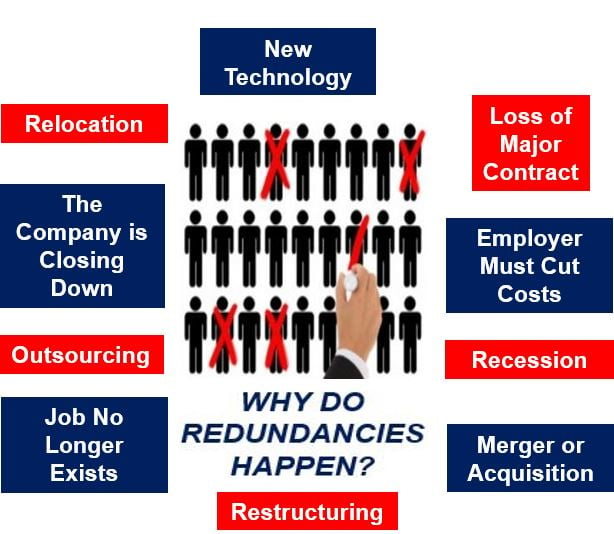If a Company Goes Bust Who Pays Redundancy? Legal Insights for UK Employees
If a Company Goes Bust Who Pays Redundancy? Legal Insights for UK Employees
Blog Article
Checking Out the Operational Dynamics of Company Redundancy and Its Long-Term Sustainability

Redundancy Techniques for Business Connection
In order to guarantee nonstop procedures, companies should execute reliable redundancy techniques for business continuity. Redundancy in this context describes the replication of important components or functions within a system to alleviate the influence of prospective failings. By incorporating redundancy techniques, companies can boost their durability versus disturbances caused by different factors such as all-natural catastrophes, devices failings, or cyber-attacks.
One usual redundancy approach is the application of backup systems and data storage space services. This entails creating duplicates of vital information and systems that can be activated in situation of a main system failing. Furthermore, companies can establish repetitive interaction networks and source of power to preserve connectivity and procedures during unpredicted occasions.
Furthermore, cross-training staff members to execute numerous duties within the business can act as a useful redundancy approach. If vital employees are unavailable due to disease or other factors, this makes sure that necessary tasks can still be carried out also. Generally, efficient redundancy techniques are essential for businesses to promote functional continuity and lessen the effect of possible interruptions.
Effect of Redundancy on Business Durability
Offered the vital duty redundancy methods play in guaranteeing business connection, checking out the influence of redundancy on business resilience comes to be imperative for comprehending the alternative functional dynamics of a firm. Organizational durability refers to an entity's capacity to adapt to disturbances, recover from problems, and transform when needed while maintaining core functions. Redundancy, when purposefully implemented, can significantly add to boosting an organization's strength despite unforeseen obstacles. By having backup systems, workers, or processes in place, business can much better endure shocks and proceed operations with very little interruption.
In addition, redundancy can reinforce employee morale and confidence, recognizing that there are contingency plans in position to attend to unforeseen circumstances. This complacency can bring about increased performance and an extra positive work environment. Additionally, redundancy can foster advancement and creative thinking within an organization as employees really feel encouraged to take computed risks, knowing that there is a safety web to sustain them in instance of failing. Generally, the effect of redundancy on organizational resilience is profound, shaping the lasting sustainability and success of a firm.
Stabilizing Effectiveness and Flexibility in Redundancy
Attaining an unified equilibrium in between operational efficiency and flexible flexibility is a pivotal challenge in the critical implementation of web link redundancy within companies. Effective operations are important for keeping efficiency and cost-effectiveness, ensuring that sources are utilized ideally. Nevertheless, too much emphasis on effectiveness alone can result in rigidity, making it tough for organizations to adapt to unpredicted adjustments or difficulties. On the various other hand, flexibility enables companies to respond nimbly to advancing scenarios, cultivating development and durability. Yet, too much adaptability without a solid operational structure can lead to inefficiencies and disparity.
To stabilize effectiveness and flexibility in redundancy preparation, companies should very carefully analyze their operational demands, market dynamics, and critical objectives. Inevitably, finding the best balance in between performance and flexibility is vital for developing a resilient and sustainable company in the face of uncertainty.
Long-Term Sustainability With Redundancy Planning
To guarantee enduring feasibility and security, companies must tactically align their redundancy preparation with lasting sustainability objectives, thereby harmonizing operational performance with flexible flexibility. Firms need to view redundancy not as a reactive option to instant issues yet as an aggressive technique for long-lasting success.

Proactive Measures for Sustainable Business Procedures
How can companies proactively boost their operational sustainability for long-lasting success? Carrying out aggressive measures is important for firms aiming to guarantee sustainable procedures. One key technique is to buy technology and technology to improve processes, reduce waste, you can look here and remain affordable on the market. Taking on lasting techniques such as lowering power consumption, lessening carbon impact, and maximizing source use can not just profit the setting yet additionally bring about set you back financial savings in the future.
Furthermore, cultivating a society of constant enhancement and discovering within the organization can enhance flexibility to altering market conditions and client demands. Urging staff member involvement in decision-making processes and helpful hints providing opportunities for specialist advancement can boost spirits, performance, and total performance. Developing clear objectives, keeping track of key efficiency indicators, and regularly reviewing development are vital elements of positive sustainability management.
Working together with providers, consumers, and other stakeholders to advertise lasting practices throughout the supply chain can produce a causal sequence of favorable impact - redundancy pay if company goes bust. By taking proactive actions towards operational sustainability, firms can build strength, drive development, and safeguard their long-term success in an ever-evolving organization landscape
Conclusion

In the world of organizational monitoring, the critical implementation of company redundancy stands as a crucial yet intricate method that demands a delicate balance in between functional effectiveness and long-term stability. By dissecting the functional dynamics that underpin firm redundancy and examining its more comprehensive effects for business durability and flexibility, a nuanced understanding of just how redundancy strategies can form the future trajectory of a company begins to unfold.Given the essential function redundancy approaches play in guaranteeing organization continuity, exploring the effect of redundancy on business resilience becomes imperative for comprehending the holistic operational characteristics of a firm. In general, the effect of redundancy on business durability is extensive, forming the long-term sustainability and success of a company.
In final thought, comprehending the operational dynamics of business redundancy is critical for ensuring long-lasting sustainability.
Report this page